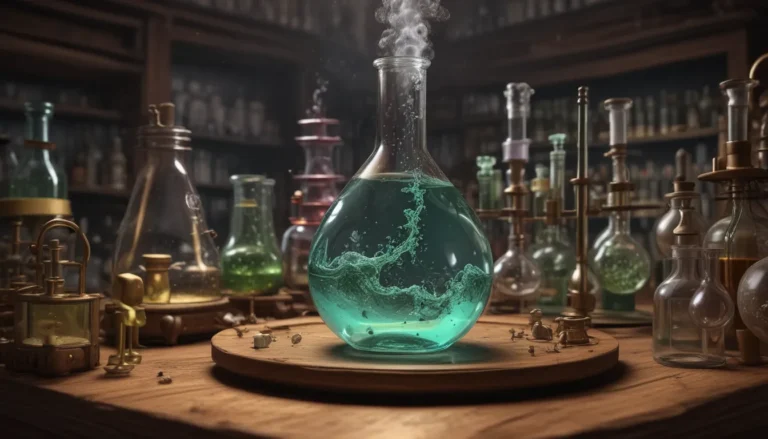A Note About Images: The images used in our articles are for illustration purposes only and may not exactly match the content. They are meant to engage readers, but the text should be relied upon for accurate information.
From the tantalizing fragrance of a blooming flower to the rich aroma of freshly brewed coffee, aromatic compounds have a magical allure that captivates our senses and sparks emotions within us. These remarkable molecules, abundantly present in nature, play a pivotal role not only in creating the delightful scents we encounter daily but also in shaping the field of chemistry.
In this comprehensive guide, we will delve into 19 extraordinary facts about aromatic compounds that will deepen your understanding and appreciation for these fascinating substances. From their intricate structure to their diverse applications in various industries, prepare to be amazed by the captivating world of aromatic compounds. So, fasten your seatbelt and get ready to embark on a journey through the aromatic wonders that lie within the realm of chemistry.
The Splendor of Aromatic Compounds:
- Aromatic compounds have unique bonding and pleasant smells, making them essential in perfumery, medicine, plastics, and more.
- Their special properties include UV-visible absorption spectra and antioxidant effects, valuable in spectrophotometry and health.
- Aromatic compounds have diverse applications and environmental impacts that are actively being studied.
Unraveling the Mysteries of Aromatic Compounds:
1. A Unique Bonding Arrangement:
Aromatic compounds exhibit a distinct bonding arrangement known as aromaticity. This feature arises from a delocalized ring of pi electrons, enhancing their stability and giving them distinctive chemical properties.
2. Pleasant Fragrances:
The term “aromatic” stems from the delightful fragrance often associated with these compounds. From the recognizable scent of benzene to the aromatic allure of essential oils, these molecules captivate our olfactory senses.
3. Abundant Natural Sources:
Aromatic compounds are prevalent in various natural sources such as plants, flowers, spices, and fruits. They contribute to the characteristic smells and flavors we commonly associate with these natural substances.
4. Role in Perfumery:
The presence of aromatic compounds in essential oils and fragrance mixtures makes them highly sought after in the perfume industry. These compounds provide distinct scents that evoke emotions and evoke memories through their aromatic profiles.
5. Dye Production:
Aromatic compounds boast unique chemical properties that make them ideal for dye production. They can absorb light at specific wavelengths, resulting in vibrant and long-lasting colors in fabrics, paints, and other dye-containing products.
6. Medicinal Significance:
Many medicinal drugs, including aspirin and antibiotics, feature aromatic compounds in their chemical structures. These compounds contribute to the therapeutic effects of the drugs and enable targeted interactions with specific biological targets.
7. Role in Plastics Industry:
The versatile nature of aromatic compounds renders them invaluable in the production of various plastics like polystyrene and PET. These plastics find extensive applications in industries such as packaging, electronics, and construction.
8. Substitution Reactions:
Due to their reactive functional groups, aromatic compounds can undergo substitution reactions where one atom or group is replaced by another. This ability allows for the synthesis of complex organic molecules with desired properties.
9. UV-Visible Absorption Spectra:
The conjugated pi electron system in aromatic compounds leads to distinctive absorption spectra in the UV and visible regions. These spectra are utilized in spectrophotometric analysis to identify and quantify aromatic compounds in diverse samples.
10. Antioxidant Properties:
Certain aromatic compounds like flavonoids found in fruits and vegetables possess antioxidant properties. These compounds aid in neutralizing harmful free radicals in the body, thereby reducing the risk of diseases associated with oxidative stress.
11. Presence in Petroleum Products:
Crude oil, a primary source of petroleum products, contains a variety of aromatic compounds such as benzene, toluene, and xylene. These compounds serve as crucial raw materials in the production of gasoline, plastics, and various other industrial products.
12. Resonance Structures:
The delocalization of pi electrons in aromatic compounds results in the formation of multiple resonance structures. These structures contribute to the stability of aromatic compounds and are pivotal in understanding their chemical behavior.
13. Fluorescence Properties:
Certain aromatic compounds exhibit fluorescence when exposed to specific wavelengths of light. This property finds applications in scientific fields such as fluorescent microscopy and the detection of environmental pollutants.
14. Combustion Energy:
Aromatic compounds possess higher combustion energies compared to non-aromatic compounds, owing to their favorable bonding arrangements. This property makes them valuable as fuels and energy sources across various industries.
15. Electrophilic Aromatic Substitution:
One of the key reactions of aromatic compounds is electrophilic aromatic substitution, where an electrophile replaces a hydrogen atom on the aromatic ring. This reaction enables the introduction of diverse functional groups into the aromatic system.
16. Industrial Applications:
Aromatic compounds find extensive utility in diverse industries, including pharmaceuticals, cosmetics, plastics, paints, and agriculture. Their unique properties and versatility make them indispensable in numerous manufacturing processes.
17. Intermolecular Interactions:
The presence of pi electrons in aromatic compounds enables them to engage in various intermolecular interactions like aromatic stacking and ?-? interactions. These interactions are crucial in molecular recognition, self-assembly, and the design of functional materials.
18. Environmental Impact Studies:
Extensive research has been conducted on the environmental impact of aromatic compounds present in pollutants. Understanding their behavior and degradation pathways aids in formulating effective strategies for environmental remediation.
19. Resonance Energy:
The delocalization of pi electrons in aromatic compounds leads to the stabilization of the system, known as resonance energy. This phenomenon plays a significant role in the stability and reactivity of aromatic compounds.
Conclusion: Exploring the Aromatic Realm
In conclusion, aromatic compounds emerge as a captivating facet of chemistry with a myriad of applications and intriguing characteristics. These compounds not only enthrall us with their enchanting scents but also serve as essential components in industries like perfumery, pharmaceuticals, and food flavoring. Understanding their unique structure and properties has paved the way for countless scientific discoveries and innovations.
The iconic aromatic compound benzene, with its distinctive ring structure and delocalized electrons, serves as the cornerstone for numerous other aromatic compounds. It lays the foundation for unraveling the mysteries of aromaticity and the governing rules that dictate its behavior. Additionally, the benzene ring holds a prominent place in natural and synthetic compounds with significant biological activities and therapeutic potentials.
Delving into the realm of aromatic compounds offers a glimpse into the interconnectedness of chemistry with our daily lives. From the scents that enchant our senses to the development of life-saving medications, the study of aromatic compounds continues to shape the world around us with its profound impact.
FAQs: Your Aromatic Queries Answered
-
What are aromatic compounds?
Aromatic compounds are a class of organic compounds featuring a unique ring structure known as an aromatic ring. These rings consist of alternating double and single bonds with a specific arrangement of atoms, leading to enhanced stability and distinct chemical properties. -
How do aromatic compounds acquire their characteristic smell?
The characteristic scent of aromatic compounds arises from their volatile nature and their interaction with our olfactory receptors. These compounds have the ability to evoke strong and pleasant odors often utilized in perfumes, essential oils, and fragrances. -
Are all aromatic compounds fragrant?
Not all aromatic compounds possess a noticeable fragrance. While many are renowned for their pleasant smells, some may have subtle odors or be entirely odorless. The aromaticity of a compound is determined by its molecular structure, influencing its aroma or lack thereof. -
What are some common uses of aromatic compounds?
Aromatic compounds find applications across various industries. They are extensively used in perfumery and cosmetics for their enchanting scents. Additionally, they play a pivotal role in the food and beverage industry as flavoring agents and hold pharmaceutical importance as vital components in medication production. -
How do aromatic compounds differ from other organic compounds?
The primary distinction lies in their ring structure and delocalized electron system. Aromatic compounds feature a specific arrangement of atoms in their rings with alternating double and single bonds, allowing for electron flow throughout the ring. This exceptional stability and reactivity set them apart from other organic compounds.
Unlock the Aromatic Enigma
Embark on a thrilling journey into the captivating world of aromatic compounds, where scents intertwine with science to create wondrous molecules that enrich our lives. From unraveling the secrets of aromatic bonding to exploring their diverse applications, the realm of aromatic compounds beckons with endless possibilities waiting to be discovered. Dive deeper into the aromatic realm, and let the enchanting allure of these compounds captivate your curiosity and imagination.
Our Commitment to Quality
Our dedication to providing reliable and engaging content underscores our mission to deliver valuable insights to our readers. Each fact shared on our platform is contributed by individuals like you, fostering a diverse pool of knowledge and perspectives. To ensure the highest standards of accuracy and authenticity, our team of editors meticulously evaluates every submission, guaranteeing that the information we offer is not only captivating but also trustworthy. Trust in our relentless pursuit of excellence as we continue to enlighten and inspire you on your quest for knowledge.
By embracing the fascinating world of aromatic compounds, you embark on a journey filled with wonder and discovery, where science and nature harmonize to create a symphony of scents and insights that enrich your understanding of the world around you. Embrace the aromatic allure and unlock the mysteries that lie within these extraordinary molecules, guiding you on a path of boundless exploration and enlightenment.






